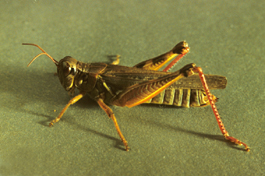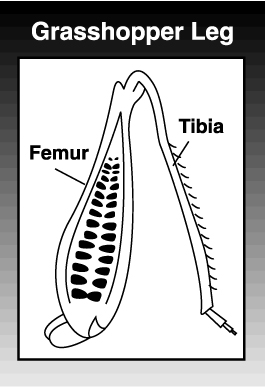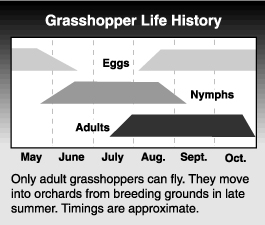by Stanley C. Hoyt and Daniel F. Mayer, originally published 1993
(Orthoptera: Locustidae)
Redlegged grasshopper
Melanoplus femur-rubrum (De Geer)
Clearwinged grasshopper
Camnula pellucida (Scudder)
Migratory grasshopper
Melanoplus sanguinipes (Fabricius)

Although there are more than 100 species of grasshoppers in Washington, few damage crops. The redlegged, clearwinged and migratory grasshoppers are the species most likely to be found in orchards in the Pacific Northwest. The redlegged grasshopper is one of the most common species of grasshopper and has the widest geographical distribution. It is found anywhere from the Arctic Circle to Central America. Grasshoppers, also known as locusts, are very destructive insects and are sporadic orchard pests. They can strip trees of foliage and may damage fruit and small wood. Young trees are particularly vulnerable.
Major outbreaks only occur when conditions are ideal for their growth and development, usually only once every 7 to 10 years. Populations build up slowly so it is fairly easy to predict bad grasshopper years. Outbreaks are worst when spring weather is warm and dry, and predators, parasites and diseases of grasshoppers are at low levels.
Hosts
The redlegged grasshopper feeds on many fruit trees, grasses, grains, field and forage crops, vines and native plants. It prefers low, moist ground. The clearwinged grasshopper usually feeds in meadows at over 2,000 feet in elevation. The migratory grasshopper is particularly destructive to small grains and alfalfa but will also attack tree fruits. It can fly long distances in search of food.
Life stages
 Egg
Egg
The egg is white and elongate.
Nymph
The nymph is similar to the adult but without wings.
Adult
The redlegged grasshopper is 3/4 to 1 inch (18 to 25 mm) long. It is gray green to yellow brown above and is yellow beneath. The hind tibiae are red. The similar-sized clearwinged grasshopper is slender and light brown with dark markings. Its hind wings are transparent. The femur is yellowish brown with 2 or 3 darker bars. The migratory grasshopper is 1 to 1-1/2 inches (25 to 37 mm) long. It is grayish to reddish brown above and yellow beneath. It has dark flecks in the center of the forewing.
Life history
There is usually one generation annually, although a partial second generation may develop some years. After the grasshoppers mate in late summer, females lay eggs in the ground in masses with a gummy coating that hardens and binds them together. The coating protects the eggs from cold during the winter. Eggs hatch in May and June. Nymphs develop through five or six instars, during which they shed their skins, and mature in summer or fall, about 40 days after hatching. Adults continue to feed and lay eggs until they are killed by cold weather. Only adults can fly.
Most grasshoppers live in the same general area throughout the year and are nonmigratory. The redlegged grasshopper makes rapid flights of only about 10 to 30 feet. They often breed in sagebrush surrounding orchards or along ditch banks and move into orchards in late summer when the grass begins to dry up. Migratory species are stronger fliers. They leave their breeding grounds when the wings are fully developed and migrate in vast swarms, setting in orchards or other cultivated areas, often devastating everything in their path.
Grasshoppers are voracious eaters and have powerful jaws and sharp mandibles for chewing up all kinds of plant life. They particularly like grasses and flowering plants.
 Damage
Damage
Feeding damage increases as the young grasshoppers mature. Grasshoppers will strip trees of foliage. Damaged trees may be more prone to winter injury.
Monitoring
Look in summer for feeding damage around or on the borders of the orchard.
Biological control
Grasshoppers have many natural enemies that play an important part in keeping them in check. Eggs are destroyed by some species of pediculid mites, parasitic wasps and flies, and the larvae of many predatory insects.
Nymphs and adults are preyed upon by wasps, ground beetles and robber flies. Some parasitoids, such as hairworms and tachinid and flesh flies attack nymphs and adults. Diseases can also keep populations down.
Management
Many chemicals used in orchards will kill grasshoppers. Insecticides are most effective against young grasshoppers. The best strategy is to control grasshoppers in the nymphal stages by spraying or baiting areas around the orchard.
